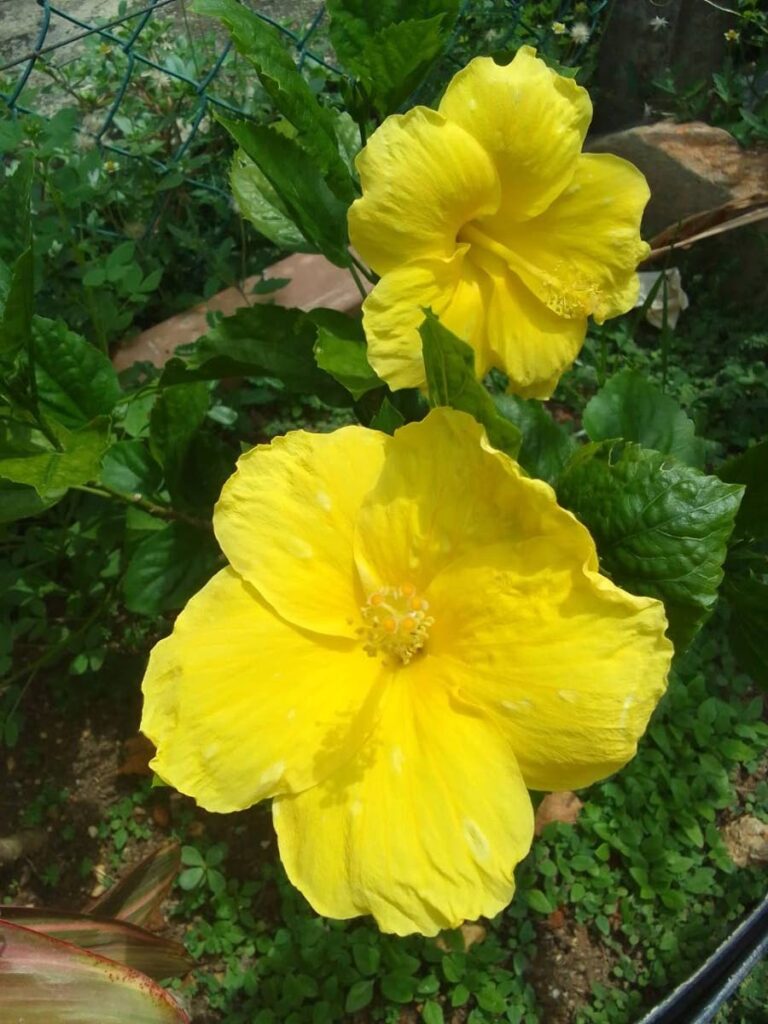Hibiscus goes beyond the boundary

JUDY MARYOUNG-ST MARTIN
HIBISCUS in Trinidad and Tobago has come a long way. Long ago it was used primarily as a fence around your home to demarcate the boundaries of your property. Today it is used as a decorative plant, planted in a prominent place to showcase its beautiful flowers.
There are over 200 different species of hibiscus plants worldwide. Each variety differs in shape, size and colour. When someone refers to hibiscus plants it is difficult to differentiate between the different types, but luckily, many of the species of hibiscus can be separated into two categories, tropical and hardy.
Tropical hibiscus is a variation that thrives in warm regions. They produce blooms that are bright in colour, with red, orange yellow, pink and white blooms being the most common. They have deep green foliage. Hardy hibiscus plants thrive in cold regions and are able to live throughout the winter once they are pruned down before winter begins.
Tropical hibiscus add beauty to anyone’s garden. They are durable plants that can grow up to 15 feet in height, and the colourful blooms will attract hummingbirds and butterflies. Hibiscus does not take a lot of effort to care for, they need moist well drained soil and full sunlight. They will also grow in partial sunlight but at the expense of the number of blooms. The life span of a hibiscus flower is short but you will see fresh new blooms the following morning, just enjoy them every day.

Hibiscus is easy to propagate; cut pieces of the stalk with leaves on it four to six inches in length, put them in water or rooting powder.
In my garden one of my favourite hibiscus flowers is a pink and white hibiscus with frilly edges. This plant grows six to nine feet tall. I knew nothing about this unusual hibiscus until one day my curiosity propelled me to get to know more about this unusual flower.
I discovered it is a Hibiscus schizopetalus, a native of tropical East Africa (Kenya, Tanzania and Mozambique), with various common names including coral hibiscus, fringed hibiscus, skeleton hibiscus, Chinese lantern and Japanese lantern although it is not native to Japan. The flowers droop from the branches in a manner reminiscent of Japanese lanterns, hence its common name. The distinctive flowers with their frilly petals and long slender column look like an oriental lantern, a parachute or a chandelier. Instead of an upward or outward-facing flower, these flowers dangle from slim arching stems.
These delicate flowers I learnt, are either a bright red colour or streaked red and pink, with long petals looking cut and fringed. The five petals are reflexed, curving back to form a sphere shape. The flowers are produced singly from leaf axils on upper stems. Plants will bloom intermittently throughout the year.

Hibiscus schizopetalus grows as a narrow, woody evergreen shrub, prefers full sun and well watered soil. They bloom better if left unpruned as the flowers are produced on short spurs from the previous year’s wood. Pruning should be done sparingly to maintain strength. Cutting back annually will limit or eliminate blossoming and also irregular watering can cause the buds to drop.
It is truly an unusual flower and I am proud to have that species in my garden. I was showing off my Hibiscus schizopetalus flower when a friend of mine realised she too has a plant in her garden and was happy to know its name.
Enjoy your varieties of hibiscus and happy gardening.
For further information contact the Eastern Horticultural Club at 357-5033, or 720-2698 or easternhorticultural@hotmail.com The Club meets on the first Saturday of every month (except public holidays) at 3 pm at the YWCA, Gordon Street, St Augustine.


Comments
"Hibiscus goes beyond the boundary"